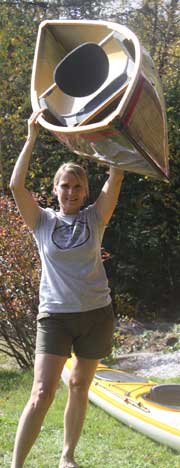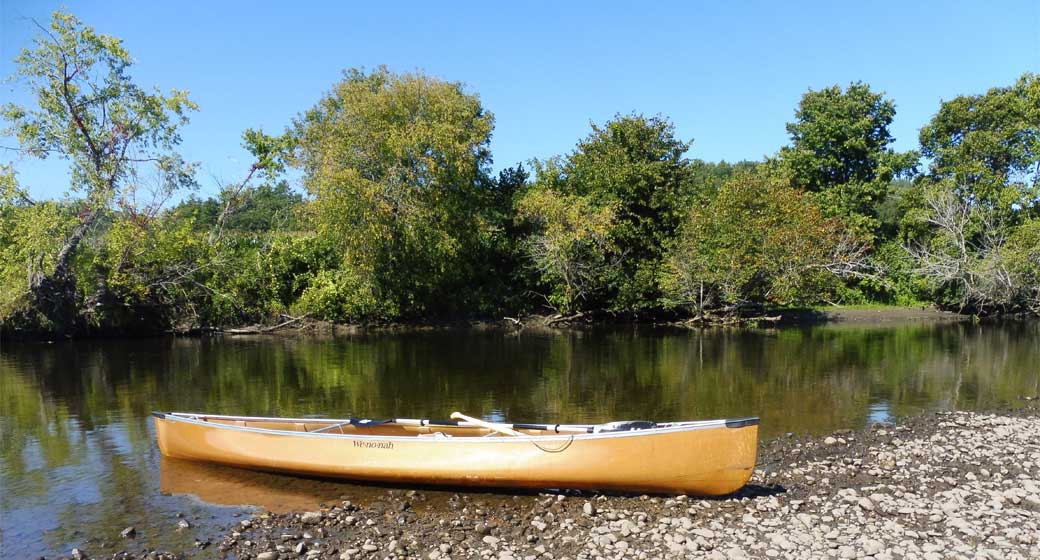




![]() Ultralight boats!
Ultralight boats!
Automobile Roof Racks
One of the most memorable moments I have of canoeing came when I was a little kid. The whole family was loaded in the ‘67 Olds Vista Cruiser (a station wagon with skylights in it), canoe on top and trailer in tow headed south on Int. 95 in southern Rhode Island for a weekend of camping. I was in my customary spot in the back end with the dog staring up through the windows at the inside of our 1932 Old Town. I was in the midst of a day dream about one of my favorite fishing holes, patiently waiting for my chance to get on the water, when the canoe broke lose from the car. I watched in horror as it sailed up over the trailer, landed on its end in the median and came to rest after several somersaults. Miraculously it sustained very little damage. It lost a 6" section of gunnel on one end and cracked a couple of ribs. Even more amazing is that it didn't hit another vehicle or cause an accident. The canoe was securely tied to the racks, the problem was that the racks came off the car. Needless to say dad invested in a good set of racks the next day, and took a bit more care in tying the old girl down.
Canoes are not cheap and it makes sense to me after spending your hard earned dollars on one that you spend a few more and purchase a decent rack system to transport it around with. Lets face it, most of us don't have a lake or river in our front yard and even if you do chances are some day you will want to canoe someplace else.
A good solid rack system is relatively cheap insurance.
If you are an experienced canoeist you already own a car with rain gutters. For me this is an absolute necessity for two reasons. One is it gives you a good solid attachment point for your racks and two it allows you to spread them out the length of the roof line which makes the canoe much more stable at high speeds and/or in high winds. The more distance you can get between your tie down points the better. For me the best buy here is a set of quick and easy brackets which can be had for about $40. The next thing you will need is a pair of 2 x 4's to use as cross pieces. Bolt them on and attach them to the car and you're ready to roll. You can get fancier if you like by using a couple of 1 X 4 hardwood slats instead of 2 X 4's but now you are spending more money. Another nice touch is to drill holes through the cross pieces to thread your rope through. Make sure to smooth out the hole or it will cut through your rope in short order. Eye bolts can be used here as well but beware they have a tendency to gouge and scratch gunnels. Be very careful in determining how long to make the cross pieces. I like having mine long enough to carry two canoes side by side. In doing this though they extend out beyond the roof line and become deadly weapons. If you are tall like me, beware when you exit your car and straighten up that you do not jam your head into them. It is most unpleasant. They tend to catch the occasional passer-by too, hopefully he/she is not a lawyer. Another nice benefit to this set up is that they are truly quick and easy to install. This is a life saver for me as my wife's car is the one with the roof racks and she doesn't enjoy banging her head into the end of the racks very often. If you do not have rain gutters on your vehicle the only problem you will have is that you will need to dig deeper into your pocket to pay for them. Both "Thule" and "Yakima" make good solid rack systems for aerodynamic roof lines. They make them for almost every car imaginable. How expensive they are depends on what type of car you have. The Thule system I have on my Areostar van cost $250. You can also purchase lots of accessories to carry skis, bikes, etc. They both offer extra long cross pieces so you can carry two canoes side by side(depending on how wide your canoes are) and they make systems for cars with rain gutters also, but not for $30. The Yakima system attaches to your car rather quickly and comes off the same way. The Thule system takes a bit more effort and time. All three of the brands discussed so far are good, solid racks. When properly installed they will not come off your car short of a nuclear explosion.
Now that we have a set of racks on our car we need to put on the canoe(s) and tie them down. Most of the time you will want to keep it centered end to end on the racks. I like to use 3/8" nylon or Dacron rope. For each canoe you will need 4 pieces of rope. The first two attach to the rack. Cut them plenty long enough to go around the rack and over the canoe with extra length for tying. Better too long than too short. After you cut them to length take a few minutes to melt the ends so they do not fray. Next I like to tie a small loop in one end, this allows you to attach it to the rack where you want it quickly, simply by wrapping it around the cross piece with a modified slip knot.
Let me take a few moments here to explain about the knots I use. Volumes of text have been written on knots, when to use them and how to tie them. I am by no means an expert and probably wouldn't even qualify as a novice. I'm sure I don't use the proper names of the few I employ. I do know however, that the ones I use work.
The next step is to throw the ropes over the canoe and tie them to the rack on the other side. I like to keep my rope right next to the side of the canoe where it meets the rack. This prevents the hull from sliding around. The knot I use here I call the canoeists knot. It works like a ratchet allowing you to get the rope extremely tight. I could probably explain it but it would take me forever. If you would like a demonstration I would be more than happy to give you one sometime. Whatever knot you use make sure you get the rope good and tight. The next pair of ropes will be attached to the bow and stern down to the bumpers. I set these ropes up with a small loop in one end just like the other pair. The trick here is to find something on the bumper to tie to. If you have a metal bumper you can drill it and attach some eye bolts. This makes the whole process quick and very secure. If you happen to have a molded plastic bumper you will have to improvise. The towing hooks underneath work well. Whatever you come up with make sure the ropes are secure and tight. Also check to make sure they do not rub across any rough or sharp surfaces that may cut them. Again cut the ropes plenty long enough to attach to one corner of the bumper, extend up through the deck of the canoe or some other solid piece of hardware, and down to the opposite corner of the bumper. The V pattern this creates helps keep the canoe from blowing from side to side. For added control you can even add a twist or loop in the rope where it attaches to the canoe. This set-up generally should work very well for you. However if you would like a little more security try lining up a thwart with the front cross piece and lash them together with rope or a rubber bungie cord. This is a nice touch for windy conditions with light weight canoes as they tend to dance around more than others. Another trick I find that works well in these conditions is to slide the canoe back on the racks so you have less of the canoe extending out in front of the front cross piece.
A less expensive, acceptable system for short hauls is the foam block carry kit. The kit usually consists of 4 foam blocks and a combination of straps and ropes. The foam blocks fit nicely over the gunnels on your canoe allowing you to set it on the roof of your vehicle. Spread the blocks out to each end of the roof. This makes the canoe more stable for the same reason it does with a more permanent rack system. It also prevents your roof from becoming dented when you torque down on the straps. At a minimum your kit will have 1 strap and 2 ropes. Once you have the canoe on the roof open the two front doors and thread the strap through them and up over the canoe. Tighten it down as hard as you can. Now when you close the doors on your car you will tighten the strap up a little bit more. Next tie down the bow and stern as described earlier. Although I have never had a canoe come off using this set-up they do tend to move around a little. I wouldn't get to excited about it though because unless the roof rips off your car, your canoe should be okay. The cost of one of these kits is around $20. Even if you have a rack system on your car foam blocks are handy to have. I use them to protect the gunnels from getting scratched where they rest on the crossbars.
As you get more involved in canoeing there will come a time when you will need to transport more then one canoe on your car. No problem. With long cross bars on your racks it is as simple as tying down the second boat. I would suggest leaving a small space between the two so they do not rub and scratch (another good use for those foam blocks). To carry 3 or more becomes a bit more involved, but it can be done. What you will need here is a pair of 2 X 4's set on top of the two canoes already tied down on your car. I have mine covered with an old blanket to keep them from scratching the hulls. Make sure you place them directly over the existing racks and tie them down at each end (4 locations). Now load on one or two more canoes. If only putting on a single canoe center it between the two existing ones and tie it down. This allows the bow and stern to nest between the other two if they happen to extend down without hitting them. Putting a pair of boats on may require a little juggling depending on the keel line and bow and stern profile. If your canoe has high ends or a fair amount of rocker, the bow and stern will hit the canoe under it before the center of it touches the rack. If you have boats of different lengths, put the shorter ones on first. If not try angling them a bit. Most of the time you will be able to come up with something that works. My record is five canoes on a Dodge Omni.
A few words of caution are in order here. Make sure you tie everything down good and tight. Rope is cheap, relatively speaking, and always carry some extra with you. Don't' expect to be able to travel at 80 MPH (remembering the speed limit is 65) with a canoe on top of the car, and the more boats you have on the more reasonable you will have to be. It is not a good idea to leave your canoes tied on your car for extended periods. The ropes are usually wet when you tie them down or become wet from dew and as they dry out they shrink concentrating tremendous pressure on a small area. I have seen many cases where hulls have been damaged. Until next time, Happy Paddling!

Have a question? I'm happy to answer it - just email me at hpcanoes@gmail.com
![]()
hpcanoes@gmail.com
603.667.5112

We specialize in ultralight solutions and offer expertise in canoes and Wee Lassie boats, as well as all the related equipment. Our favorites are Wenonah canoes and Wee Lassie boats. Although we will work with any material we like to get folks set up with lightweight canoes so you can dedicate your time to the joy of being out on the lakes and rivers instead of struggling to move your boat between car and water.
Scott Edwards, "Hemlock Pete" himself, offers you decades of paddling expertise. He is friendly, down-to-earth, and provides superior customer service. You won't find a better, or more pleasant, deal elsewhere.

